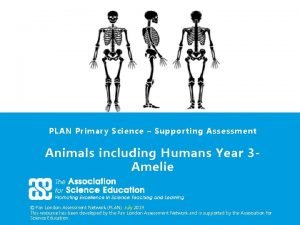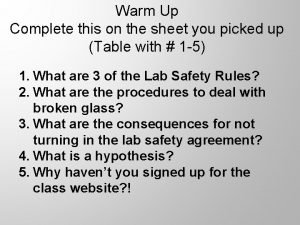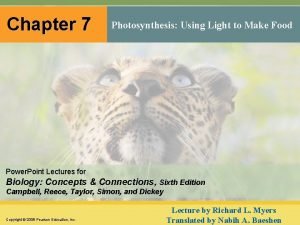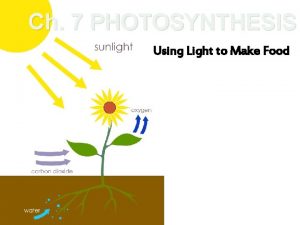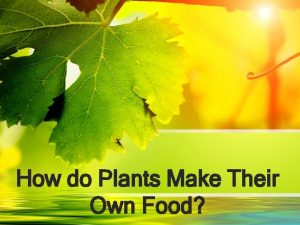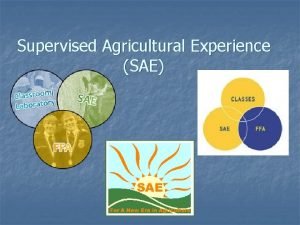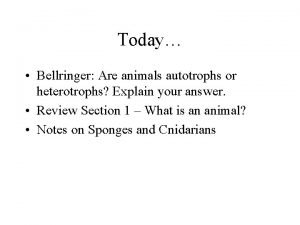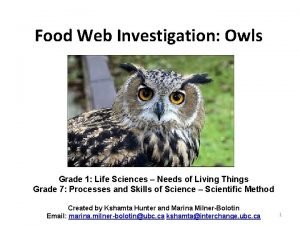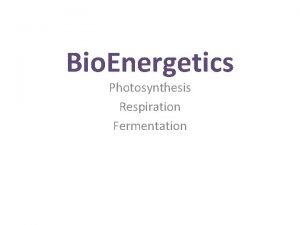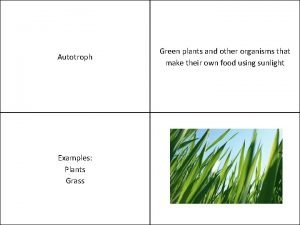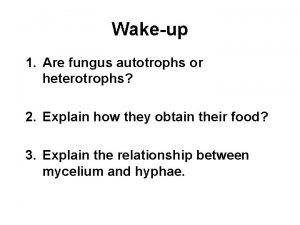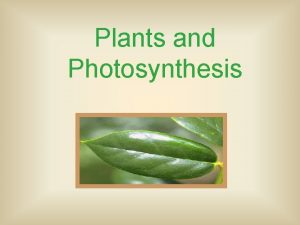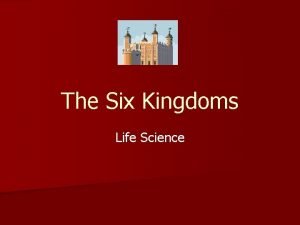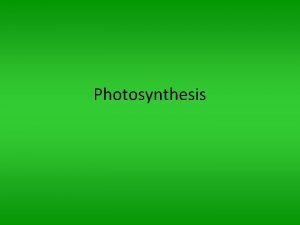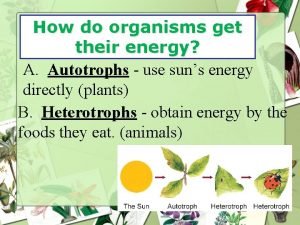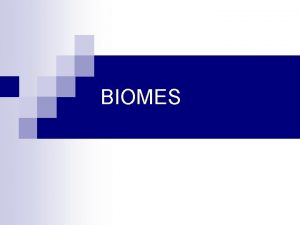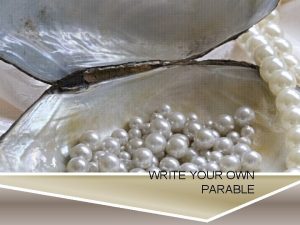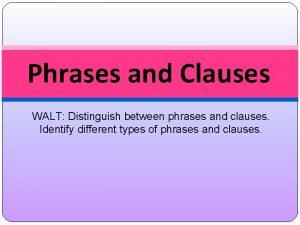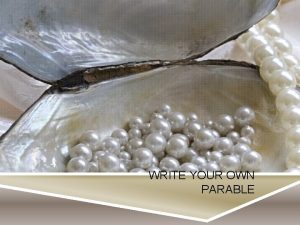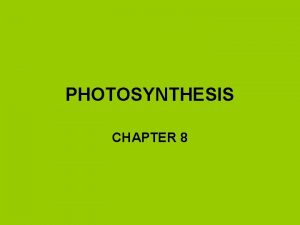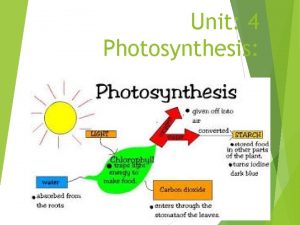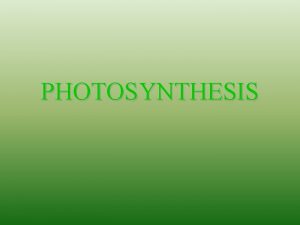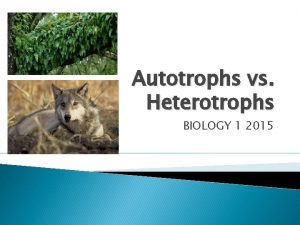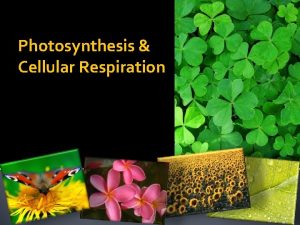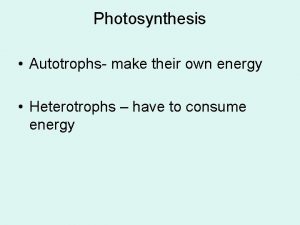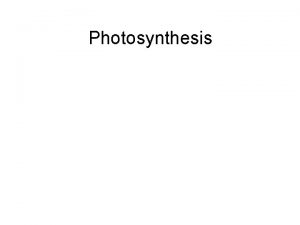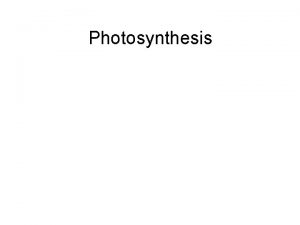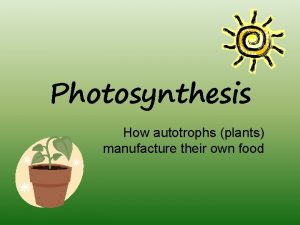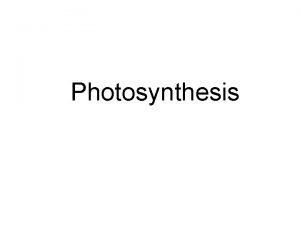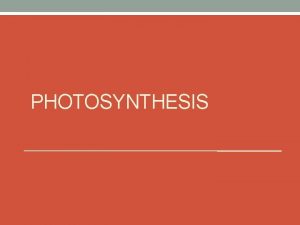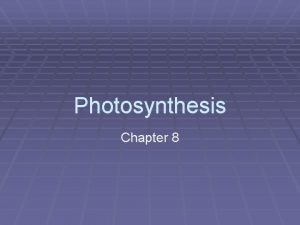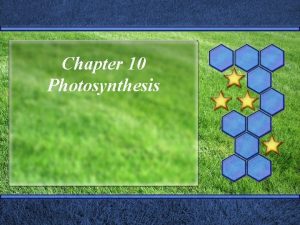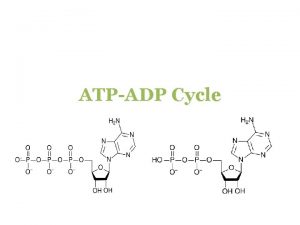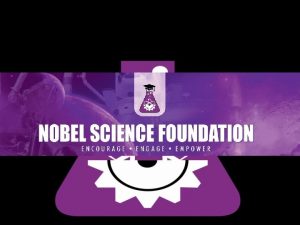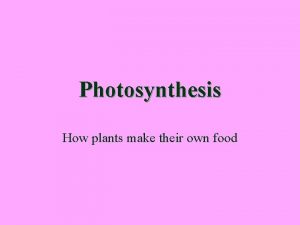Introduction to Photosynthesis AUTOTROPHS make their own food




























- Slides: 28

Introduction to Photosynthesis

› AUTOTROPHS �make their own food. �Ex: Phototrophs…. Use light energy �Ex: Chemotrophs…Use inorganic compounds › HETEROTROPHS �Must eat org. mol. for energy (carbon source).

FM

Light �Form of energy › Other forms of energy are: �heat, electrical, kinetic, sound, chemical �Travels in waves (different wavelengths)

Wavelength (λ)

Photosynthesis (Psyn): � Process: Light chemical energy ( sugars) � Pigments used to capture light energy

� Light and Pigments �How do plants capture the energy of sunlight? In addition to water and carbon dioxide, photosynthesis requires light and chlorophyll. Copyright Pearson Prentice Hall

�Plants gather the sun's energy with light-absorbing molecules called pigments. �The main pigment in plants is chlorophyll. �There are two main types of chlorophyll: �chlorophyll a �chlorophyll b Copyright Pearson Prentice Hall

�Chlorophyll absorbs light well in the blue-violet and regions of the visible spectrum. Estimated Absorption (%) 100 80 60 Chlorophyll b Chlorophyll a 40 20 0 (nm) 400 450 Wavelength 500 550 600 650 700 750 Wavelength (nm) Copyright Pearson Prentice Hall

�Chlorophyll does not absorb light well in the green region of the spectrum. Green light is reflected by leaves, which is why plants look green. Estimated Absorption (%) 100 80 60 Chlorophyll b Chlorophyll a 40 20 0 400 450 500 550 600 650 700 750 Wavelength (nm) Copyright Pearson Prentice Hall

�Light is a form of energy, so any compound that absorbs light also absorbs energy from that light. �When chlorophyll absorbs light, much of the energy is transferred directly to electrons in the chlorophyll molecule, raising the energy levels of these electrons. �These high-energy electrons are what make photosynthesis work. Copyright Pearson Prentice Hall

Pigments

Chlorophyll a �Chlorophyll a › C 55 H 72 O 5 N 4 Mg › Molecular wt. 893. 5 › Blue-Green (Not on test)

Chlorophyll b �Chlorophyll b › C 55 H 70 O 6 N 4 Mg › Molecular wt. 907. 5 › Yellow-Green (Not on test)


Anthocyanin �C 15 H 11 + O �Blue, red, pp � fruit, flowers (Not on test)

ß Carotene �C 40 H 56 �Mol. wt. 536. 9 �Orange, Orange Red (Not on test)

Xanthophyll �C 40 H 56 O 2 �Mol. Wt. 568 �Yellow (Not on test)

Chromatography � Splitting apart pigments


� Evergreen plants › psyn. year round. � Deciduous plants › affected by temp. and light changes; leaves change color - drop. � Factors affecting the rate of psyn. › Temperature › Water availability › Intensity of light › CO 2 availability

KEY CONCEPT The overall process of photosynthesis produces sugars that store chemical energy.

Photosynthetic organisms are producers. Producers make their own source of chemical energy. � Plants use photosynthesis and are producers. � Photosynthesis captures energy from sunlight to make sugars. �

� Chlorophyll is a molecule that absorbs light energy. chloroplast • In plants, chlorophyll is found in organelles called chloroplasts. leaf cell leaf

Photosynthesis in plants occurs in chloroplasts. � Photosynthesis takes place in two parts of chloroplasts. › grana (thylakoids) › stroma grana (thylakoids) chloroplast stroma

� The light-dependent reactions capture energy from sunlight. – – take place in thylakoids water and sunlight are needed chlorophyll absorbs energy is transferred along thylakoid membrane then to light-independent reactions – oxygen is released

� The light-independent reactions make sugars. – take place in stroma – needs carbon dioxide from atmosphere – use energy to build a sugar in a cycle of chemical reactions

� The equation for the overall process is: 6 CO 2 + 6 H 2 O C 6 H 12 O 6 + 6 O 2 granum (stack of thylakoids) 1 s chloroplast un lig ht 6 H 2 O thylakoid 6 CO 2 3 6 O 2 2 energy stroma (fluid outside thylakoids) 1 six-carbon sugar 4 C 6 H 12 O 6
 Photosynthesis glossary
Photosynthesis glossary Green plants make their own food by photosynthesis
Green plants make their own food by photosynthesis Animals can make their own food
Animals can make their own food Animals can make their own food
Animals can make their own food Organisms that make their own food
Organisms that make their own food The process of photosynthesis
The process of photosynthesis Photosynthesis using light to make food
Photosynthesis using light to make food Chloroplast function
Chloroplast function What type of sae is when you own your own business
What type of sae is when you own your own business Hollow bodied animals
Hollow bodied animals Burrowing owl food chain
Burrowing owl food chain Autotrophs and heterotrophs
Autotrophs and heterotrophs Is grass an autotroph
Is grass an autotroph Autotrophic vs heterotrophic
Autotrophic vs heterotrophic Are fungi autotrophs or heterotrophs
Are fungi autotrophs or heterotrophs Autotrophs self-feeder
Autotrophs self-feeder Phylum name
Phylum name Archaebacteria body type
Archaebacteria body type Autotrophs
Autotrophs Cellular respiration equation
Cellular respiration equation Is eubacteria terrestrial or aquatic
Is eubacteria terrestrial or aquatic How living things obtain energy worksheet answers
How living things obtain energy worksheet answers Unit 2 food food food
Unit 2 food food food Food chain food chain food chain
Food chain food chain food chain Own parable
Own parable Phrases and clauses with examples
Phrases and clauses with examples How to write a parable
How to write a parable Make your own folds and faults answer key
Make your own folds and faults answer key Write your own declaration
Write your own declaration



